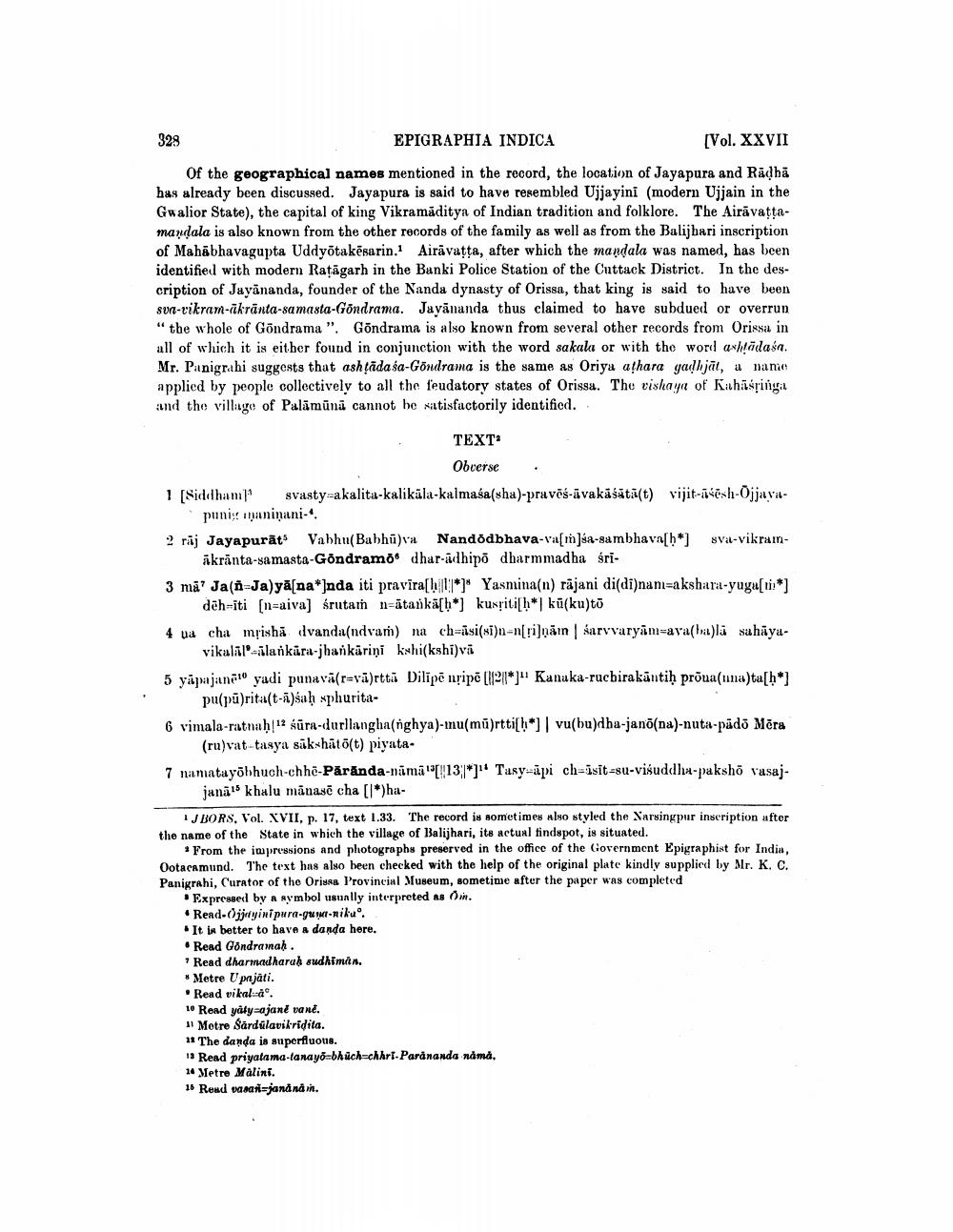________________
329
EPIGRAPHIA INDICA
[Vol. XXVII
Of the geographical names mentioned in the record, the location of Jayapura and Radhā has already been discussed. Jayapura is said to have resembled Ujjayini (modern Ujjain in the Gwalior State), the capital of king Vikramaditya of Indian tradition and folklore. The Airāvattamandala is also known from the other records of the family as well as from the Balijhari inscription of Mahābhavagupta Uddyõtakësarin. Airāvatta, after which the mandala was named, has been identified with modern Rațägarh in the Banki Police Station of the Cuttack District. In the description of Jayananda, founder of the Nanda dynasty of Orissa, that king is said to have been sun-vikram-ākrānta-samasta-Göndrama. Jayānanda thus claimed to have subdued or overrun "the whole of Göndrama". Göndrama is also known from several other records from Orissa in all of which it is either found in conjunction with the word sakalı or with the word a hädasa. Mr. Panigrahi suggests that ashtādaśa-Göndrama is the same as Oriya athara gadhjāt, a name applied by people collectively to all the feudatory states of Orissa. The vishaya of Kithaspingi and the village of Palāmūnā cannot be satisfactorily identified.
TEXT
Obverse : 1 [Siddhamli svasty-akalita-kalikāla-kalmasa(sha)-pravēš-avakāśātā(t) vijit-āšēsh-Öjjava
punis maniņani2 rāj Jayapurāts Vabhu(Babhūva Nandodbhava-va[m]sa-sambhava[h*) Sva-vikram
äkrinta-samasta-Gondramo dhar-adhipo dharmmadha sri3 mā? Ja (7-Ja)yā[na*]nda iti pravirachill*** Yasmina(n) rājani di(di)nan-akshara-yuyu[11*]
deh-iti (n=aiva] śrutar n=ātarkā[h*) kusitish*kü(ku)to 4 wa cha mrishā dvanda(ndvam) na ch=āsi(si)n=n[i]ņāın karvvaryam-ava(a)la sahaya
vikalal-ilankira-jhankariņi kshikshi)va 5 yapajanēto yadi punavä(r=vā)rtti Dilipo nyipē [121*]" Kanuka-ruchirakāntiḥ prõuanna)tu[h*]
pu(pū)rita(t-a)śaḥ sphurita6 vimala-ratnah12 sūra-durllangha(nghya)-mu(mū)rtti[h*] vu(bu)dha-jano(na)-nuta-pädo Mora
(ru)vat-tasya sākshāto(t) piyata7 namatayõbhuch-chhi-Pärānda-nimā''[1131*]** Tasy=āpi ch=isit-su-visuddha-pakshö vasaj
janās khalu mānasē cha [l*)haIJ BORS, Vol. XVII, p. 17, text 1.33. The record is sometimes also styled the Narsingpur inscription after the name of the State in which the village of Balijhari, its actual tindspot, is situated.
From the impressions and photographs preserved in the office of the Government Epigraphist for India, Ootacamund. The text has also been checked with the help of the original plate kindly supplied by Mr. K. C. Panigrahi, Curator of tho Orissa Provincial Museum, sometime after the paper was completed
• Expressed by a symbol usually interpreted as On. • Read-Ojjnyinipura-gu -Riku'. . It is better to have a danda here. • Read Göndramah.
Read dharmadharah sudhiman. * Metre Uprjāti. . Read vikalo 10 Read yaly-ajané vane. 11 Metre Sardúlavikridita. 11 The danda is superfluous. 13 Read priyatama-lanayo-bhuchuchhrl. Parananda nama. 14 Metre Malini. 16 Read vasantsjana näin.




